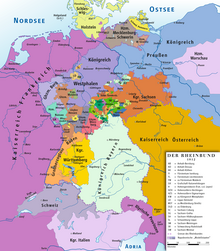Treaty of Ried
With the Treaty of Ried of October 8, 1813, the Kingdom of Bavaria left the Confederation of the Rhine and moved to the camp of the anti-Napoleonic allies. The treaty became the model for similar treaties with other Rhine Confederation states.
prehistory
As early as March 1813, Klemens Wenzel Lothar von Metternich tried to persuade Bavaria to change sides. The temporary military successes of Napoleon in the spring campaign led to a wait-and-see attitude towards King Maximilian I Joseph . General Carl Philipp von Wrede and the Crown Prince and later King Ludwig I , and finally the Supreme Minister Maximilian von Montgelas , increasingly called for a change of sides . The fact that Prince Schwarzenberg, on behalf of the Emperor of Austria, promised the unchanged sovereign and territorial continuation of Bavaria on March 30th, had contributed to the reduction of various fears . The change in Bavarian politics then led to the conclusion of the Ried Treaty and secret additional agreements. Heinrich XV signed for the Austrian Empire . Reuss to Greiz . Prince Carl Philipp von Wrede signed for Bavaria.
content
The contract consisted of eleven articles and eleven secret articles. Bavaria then left the Confederation of the Rhine and promised to take part in the war against Napoleon with an army of at least 36,000 men. In return, Austria, which had previously ceded considerable areas in the Peace of Schönbrunn, guaranteed Bavaria the ownership and recognized its full sovereignty. Equivalent compensation was promised for assignments of territory to be negotiated later.
consequences
After Bavaria had declared war on France on October 14, 1813, the Austrian allies Prussia and Russia joined the Treaty of Ried. Similar treaties were later concluded with other Rhine Confederation states.
See also
literature
- Volker Schäfer: Treaty of Ried. In: Gerhard Taddey (Hrsg.): Lexicon of German history . People, events, institutions. From the turn of the times to the end of the 2nd World War. 2nd, revised edition. Kröner, Stuttgart 1983, ISBN 3-520-80002-0 , p. 1050.
Web links
Individual evidence
- ^ Andreas Kraus , History of Bavaria , p. 396. ISBN 3-406-09398-1
